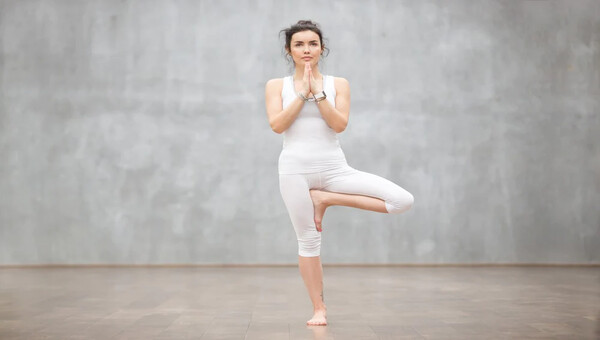How to Enhance Your Posture and Alignment with Yoga Asanas (Poses)

In our modern, sedentary lifestyles, poor posture has become a prevalent issue that can lead to various physical discomforts and health problems. The practice of yoga offers a powerful solution to improve posture and alignment by strengthening the core, stretching tight muscles, and promoting body awareness. Yoga asanas (poses) are designed to not only enhance flexibility and strength but also cultivate proper alignment, which is vital for maintaining a healthy and pain-free body. In this blog, we will explore how incorporating yoga asanas (poses) into your daily routine can help you achieve better posture and alignment for a healthier and more balanced life.
Here are 10 way Yoga Can Help Enhance your Posture
1. Develop Body Awareness
One of the fundamental aspects of yoga is cultivating body awareness. As you move through various asanas, pay close attention to how your body feels in each posture. Focus on aligning different body parts correctly and mindfully engage the muscles necessary for maintaining stability and balance. This heightened awareness helps you identify any areas of tension or misalignment and empowers you to make adjustments accordingly.
2. Engage Your Core
A strong core is essential for good posture and alignment. The core muscles, including the deep abdominal muscles and the muscles along the spine, support the torso and help maintain an upright posture. Incorporate core-strengthening asanas like Boat Pose (Navasana), Plank Pose (Phalakasana), and Boat Pose (Navasana) into your practice to build a stable and supportive core.
3. Focus on the Spine
The spine plays a crucial role in maintaining proper posture. Yoga asanas can help elongate and strengthen the spine, promoting better alignment. Practice poses that involve spinal extension, such as Cobra Pose (Bhujangasana) and Upward Facing Dog (Urdhva Mukha Svanasana), to counteract the effects of slouching and rounded shoulders.
4. Stretch Tight Muscles
Sitting for prolonged periods and poor posture can lead to tight muscles, particularly in the shoulders, chest, hips, and hamstrings. Yoga asanas provide effective stretches to release tension in these areas and improve flexibility. Poses like Cow Face Pose (Gomukhasana), Seated Forward Bend (Paschimottanasana), and Pigeon Pose (Eka Pada Rajakapotasana) are beneficial for opening tight muscles and restoring balance in the body.
5. Create Space in the Joints
Certain yoga asanas help create space in the joints, allowing for better alignment and ease of movement. Poses like Downward Facing Dog (Adho Mukha Svanasana) and Extended Triangle Pose (Utthita Trikonasana) stretch and elongate the spine and limbs, promoting a sense of spaciousness in the body.
6. Balance Asanas for Symmetry
A balanced yoga practice includes poses that work both sides of the body equally. This balance ensures that one side does not become stronger or more flexible than the other, which can lead to asymmetrical posture. Incorporate asanas that work bilaterally, such as Warrior Poses (Virabhadrasana), to promote symmetry and alignment.
7. Use Props for Support
Yoga props, such as blocks, straps, and bolsters, can be valuable tools for improving alignment and deepening stretches. Props provide support and assist in achieving proper alignment, especially in more challenging poses. They can be particularly helpful for beginners or individuals with limited flexibility.
8. Mind Your Shoulders and Neck
Tension in the shoulders and neck is a common issue associated with poor posture. Practice shoulder-opening asanas like Shoulder Bridge Pose (Setu Bandhasana) and Shoulder Opener Stretch to release tightness in the upper body and prevent rounded shoulders.
Related Post – How to Incorporate Breathing Techniques (Pranayama) into Your Daily Routine
9. Incorporate Inversions
Inversions, where the head is below the heart, are excellent for realigning the spine and improving blood circulation. Poses like Shoulder Stand (Sarvangasana) and Headstand (Sirsasana) are advanced inversions that can greatly benefit posture and alignment when practiced safely and correctly.
10. Relax and Practice Savasana
Savasana, or Corpse Pose, is a final relaxation pose that allows the body to integrate the benefits of the yoga practice. It is an opportunity to release any lingering tension and find a sense of stillness and alignment. Use this time to allow your body to fully relax and reset after your asana practice.
Conclusion
Yoga asanas offer a comprehensive approach to enhancing posture and alignment, promoting better overall health and well-being. By developing body awareness, engaging the core, focusing on the spine, stretching tight muscles, creating space in the joints, balancing asanas, using props for support, minding the shoulders and neck, incorporating inversions, and practicing relaxation, you can achieve significant improvements in your posture and alignment.
Regular yoga practice not only improves physical alignment but also cultivates mindfulness and a deeper connection with your body. As you integrate these principles into your practice, you’ll find that the benefits of improved posture extend beyond the mat, positively impacting your daily activities and quality of life. Embrace the transformative power of yoga asanas, and witness how this ancient practice guides you towards a healthier, more aligned, and balanced self.




